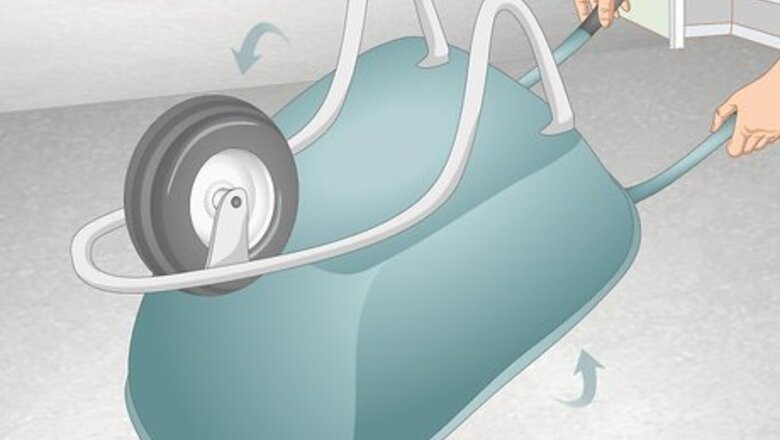
views
Removing the Tire
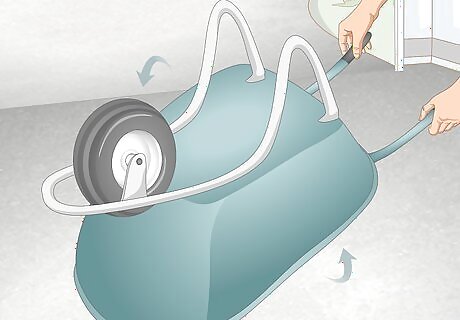
Turn your wheelbarrow upside down to make things easy. Take your wheelbarrow and carefully tilt it over until the tray is flat on the ground. This will stabilize your wheelbarrow while you remove the tire from the wheelbarrow’s frame. If you aren’t sure if your tire has a tube or not, look at the air valve sticking out of the center of the wheel. If the valve is fixed tight into the frame of the wheel, your tire is tubeless. The repair process for a tube tire is a little different, so check to be sure that your tire is tubeless before proceeding.
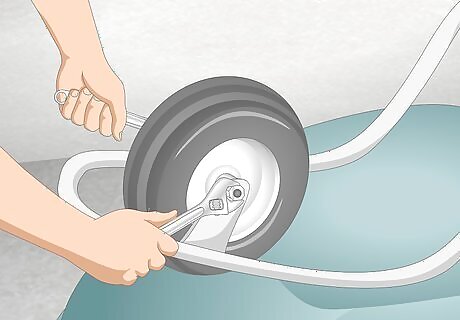
Remove the nut in the center of the wheel with 2 wrenches. Take 2 wrenches and use the rotating nut in the center of each tool to adjust the jaws. Match the jaws to the size of the nuts in the center of the wheel. Use your nondominant hand to grip one of the nuts with a wrench. Hold this nut in place while you rotate the nut on the opposite side of the axle with your wrench by turning it counterclockwise. Continue turning the nut until you can remove both sides by hand.Variation: Some wheelbarrows hold the wheel in place with cotter pins, which look like 2 lengths of metal with a round end. To remove cotter pins, grip the round end of each pin with a pair of pliers and pull them away from the center of the wheel. You can use 2 sets of channel locks instead of wrenches if you prefer.
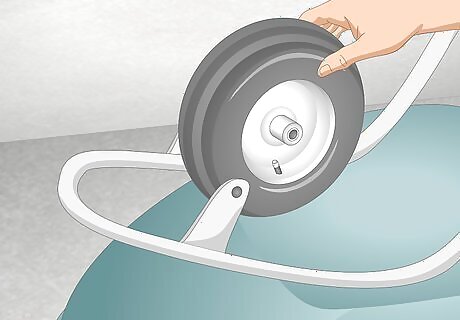
Slide the wheel out of the wheelbarrow and set it aside. Set the nuts on a stable work surface or stuff them in your pocket to avoid losing them. Then, lift the wheel out of the frame to detach it from your wheelbarrow. Place the wheelbarrow flat on a stable work surface.
Finding the Leak
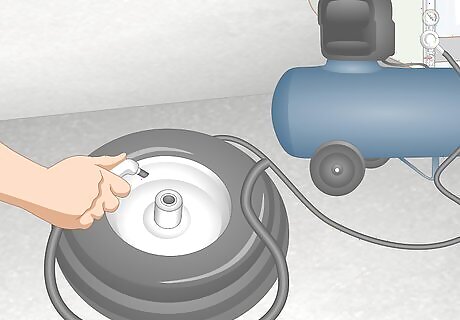
Fill the tire with air using a compressor or pump. To figure out where your leak is coming from, get an air compressor or a high-quality air pump. Remove the cap on the air valve and fill the tire with air until the rubber is taut and firm. If you have a custom psi gauge on the compressor, set it to 25-30 psi based on your tire’s pressure restrictions.Tip: If the leak is coming from the exterior side of the tire, use a tire plug kit to fill the hole and patch it. If the interior edge of the tire, called the bead, isn’t sticking to the rim, your tire will leak air from inside. Use a nylon strap or rope to fix the bead if that is the issue. The maximum tire pressure is listed on the side of the tire. If you can’t find a pressure limitation, assume that your tire can hold a maximum pressure of 25 psi to stay on the safe side. If you can, get an air compressor to do this. Using an air pump to fill a wheelbarrow tire can be quite a pain. If you have to use an air pump, enlist a friend or family member to pump for you while you work on the tire.
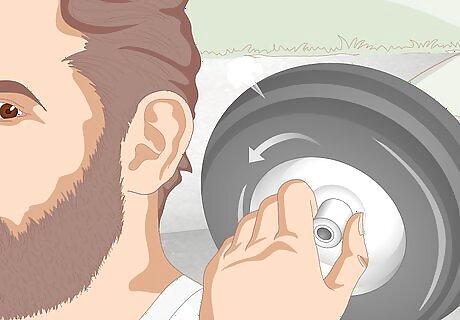
Rotate the tire while listening carefully for the leak. With your tire filled, slowly and quietly rotate the tire to listen for a leak. Use your ear to identify the area where air is escaping. Once you narrow down the area, inspect the tire visually to see if you can spot a tear or rip. If you can’t find one, run your hand over the surface to feel for air escaping to find the gap. If the tire deflates before you have an opportunity to find the leak, refill the tire with air and continue searching. It may take a few tries before you can find the leak. If there is no leak and your tire is deflated, the problem is the bead of your tire.
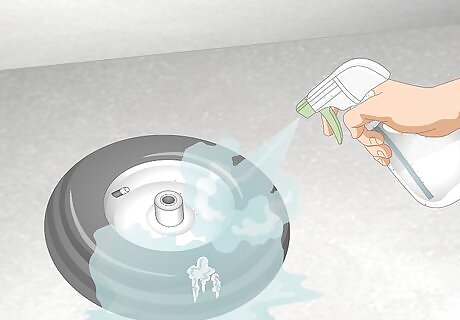
Spray your tire with soapy water if you can’t find the leak. If you really can’t find the leak but definitely hear air escaping, grab an empty spray bottle. Fill the bottle with water and add a few squirts of dish soap. Shake the bottle up and liberally spray every external surface of your wheel. Then, inspect your wheel and look for bubbles. The hole or tear will be at the location where you see the soapy water bubbling up. It really doesn’t matter how much soap you use so long as it’s bubbly. If you have a tear that is longer or wider than 1 in (2.5 cm), you’re better off simply replacing the tire. Even if you repair a large tear in the tire, it’s extremely likely to reopen in the future. A new tire will cost $15-50 depending on the size and brand.
Fixing a Punctured Tire
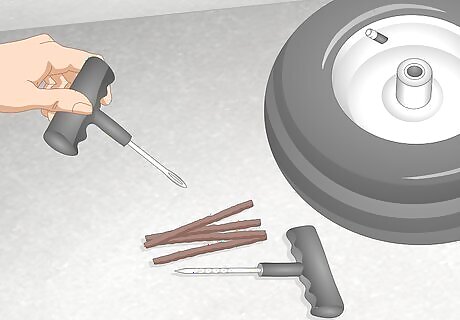
Get a tire plug kit with a reamer, applicator, and rubber plug. A tire plug kit is a small set of tools that you can purchase together to fill minor leaks in a tire. It includes a rubber plug, a reamer, and an applicator. The reamer is designed to make the hole round, and the applicator is a small metal pole with a loop at the end. Buy a tire plug kit online or at your local auto parts store. Building Your Own Kit: Tire repair kits that are designed for wheelbarrows can be kind of hard to find. While you may be able to use a kit designed for cars or bikes, you can always put your own kit together using the following tools: Nail or screwdriver (to replace the reamer) Piece of hard rubber (to replace the plug) Thin pliers (to replace the applicator)
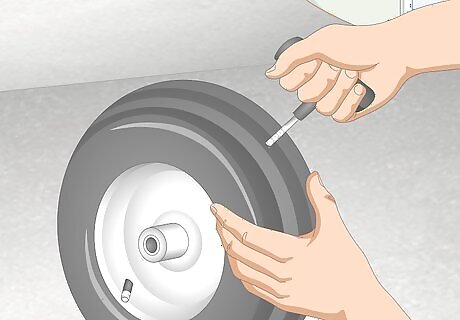
Insert the sharp end of the reamer into the hole to make it round. Hold the tire upright on the rubber and brace it with your nondominant hand. Then, force the pointy end of the reamer through the hole to enlarge it. Slide it in 1–3 in (2.5–7.6 cm) to smooth down the edges of the hole. This will create a hole with an equal amount of resistance on each side. Do not remove the reamer once you insert it. If you can’t get the reamer into the hole because the tire is too deflated, fill the tire with your air compressor or pump before doing this. If you don’t have a reamer, you can force the head of a nail or screwdriver through the opening of the hole and hold it in place.
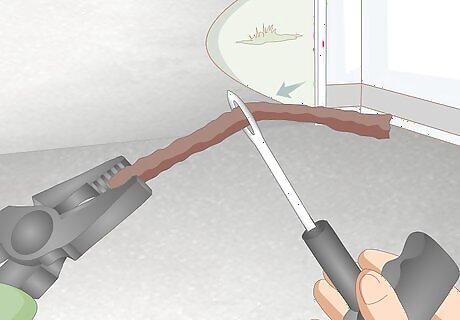
Thread the rubber plug through the opening on the applicator and pull it through. The applicator is a metal rod with an oval-shaped opening at one end. Take your rubber plug and pinch it at the end. Force the pinched end into the opening at the end of the applicator. Once the rubber is poking out of the other side, use a pair of pliers to grip the rubber and pull it all the way through. Continue pulling the rubber through the applicator until you reach the middle of the rubber plug. The applicator has a small 0.25–0.5 in (0.64–1.27 cm) gap at the end of the oval-shaped opening. The applicator is used to force the rubber plug into the opening before pulling the applicator out. If you don’t have an applicator, simply grip the middle of the plug with a pair of thin pliers.
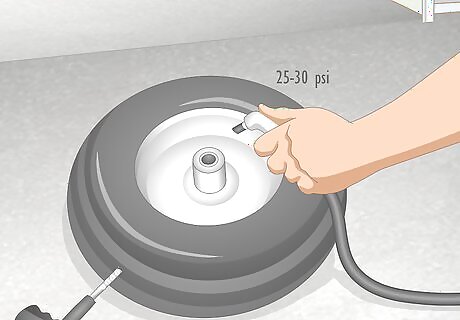
Use a compressor or air pump to fill the tire to 25-30 psi. With the reamer sticking in your tire, remove the valve cap on the air valve. Insert your compressor or pump and fill the tire with air. Continue filling the tire until the rubber is tight and the pressure is between 25-30 psi. Reattach the cap by turning it clockwise until it won’t move any further to close it. Don’t worry if a little air escapes while you’re holding the reamer in place. It’s okay if a little air gets out.
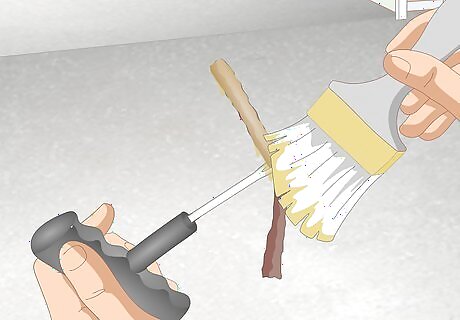
Coat the rubber plug in rubber cement with a brush. Take a bottle of rubber cement and open the cap. Use the built-in brush or grab a clean 1–2 in (2.5–5.1 cm) natural paint brush. Dip the brush into the rubber cement and liberally coat each portion of the rubber plug with the rubber cement. If you want to keep your work surface clean, put a towel underneath the plug as you apply the cement to catch drips.
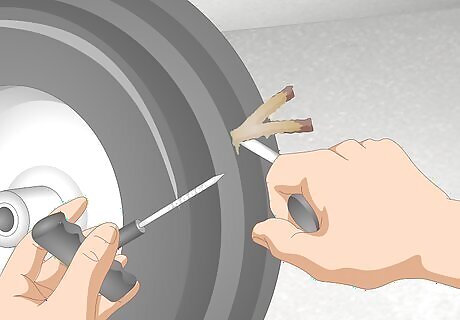
Remove the reamer and force the applicator through the hole. Keep the tire still by bracing it against your body or setting it on its side. Then, pull the reamer out of the hole. As soon as you can, stick the applicator through the center of the hole. Push it in so that the rubber plug folds in half. Continue to push the plug into the tire until roughly half of the plug is sticking out the top of the tire. This can be kind of awkward to do without an extra set of hands. If you can, ask a friend or family member to hold the tire for you while you do this. Be prepared to use a little force to shove the plug through the hole. The rubber plug is bigger than the hole you made with the reamer, so this can be a little tough.
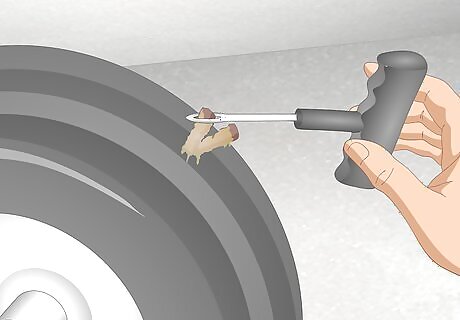
Lift the applicator out to leave the rubber plug in the hole. Once the plug is roughly halfway in the tire, pull the applicator up to release the plug. The tension from the hole will hold the plug in place as it slides out of the thin opening at the end of your applicator. If you accidentally push too hard and shove the plug entirely into the tire, lift it out through the hole slowly to catch it in place and pinch the plug while you slide the applicator out.
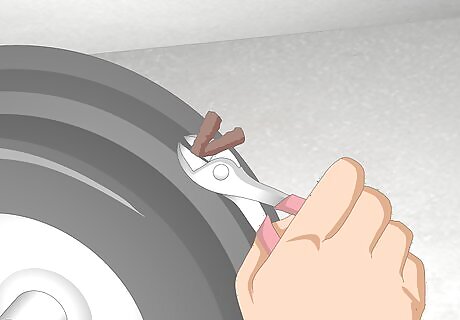
Clip the excess rubber with a pair of snips or wire cutters. Tor remove the excess rubber, grab a pair of snips or wire cutters. Clip the rubber near the base of the tire to cut the excess length off. If your rubber is softer, feel free to use scissors instead. Give the rubber cement 12-24 hours to completely dry. When the cement is dry, refill the tire with air if necessary. You can pour tire sealant over the plug if you’re worried about it sliding out. This shouldn’t be necessary if the hole is adequately sealed. Reattach the wheel by placing it in the frame of the wheelbarrow and tightening the nuts.
Repairing the Bead of the Tire
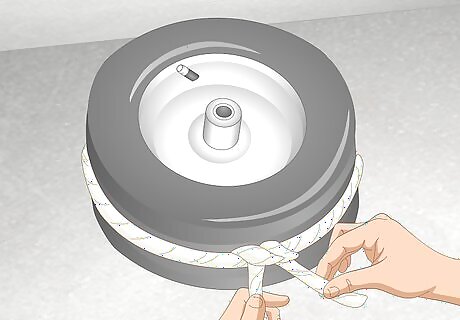
Tie a rope or nylon ratchet strap around the center of the tread. If the problem is with the bead where the tire meets the rim, grab a nylon ratchet strap or length of rope. Take the strap and wrap it around the exterior circumference of the tire. Close the clip to attach the strap to the tire. If you’re using rope, wrap it around the center of the tire and tie it in a knot at the top. While it isn’t a popular option, you may be able to use a bungee cord instead of a rope if you don’t have anything else. A nylon strap will be easier to use than a rope, but most people don’t have a ratchet strap small enough to fit a wheelbarrow’s tire.
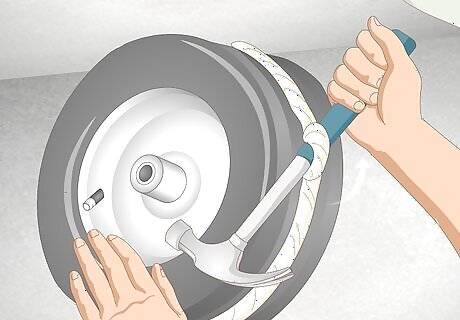
Tighten the rope or strap until the tire can’t be tightened further. To tighten a ratchet strap, lift the handle on the clip upwards and force it back down to tighten the nylon. Repeat this process until you can’t tighten it further. If you’re using a rope, slide the handle of a hammer under the rope and twist the head of the hammer in either direction to tighten it.Tip: If you’re using a hammer to tighten your rope, you’ll need to hold it in place while you complete the rest of the steps. You can use any tool with a firm handle instead of a hammer. A wrench, channel locks, or socket wrench will also do the job.
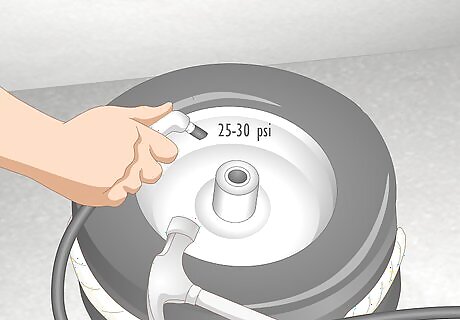
Use an air compressor or pump to fill the tire up to 25-30 psi. With the strap or rope tightened, remove the cap on the air valve. Insert the tip of your air compressor or air pump and fill the tire. Continue adding air until the tire is entirely filled. You should see the bead of the tire pushing into the rim until it’s completely tight. If the bead gets stretched out, it won’t adhere to the rim. Filling it with air while you’re holding the exterior edge down with the strap or rope forces the air to press on the bead. This will cause the bead to reshape around the rim which should fix your dysfunctional tire.
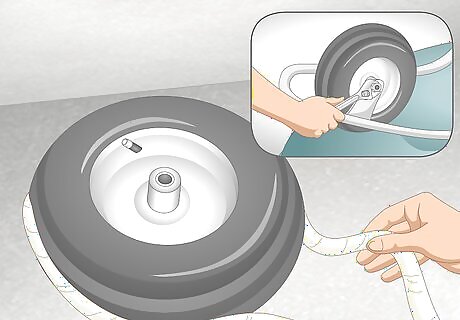
Remove the strap or rope and reattach your tire. Wait 20-30 seconds to give the bead time to stick to the rim. Then, remove the nylon strap by unclipping it or loosening it and sliding it off. If you’re using a rope, turn your hammer in the opposite direction to loosen the rope and undo the knot. Roll your tire back and forth to ensure that it is rolling properly. If the rim looks even and taut against the bead but the tire is still a little soft, fill it up with air to ensure that you didn’t create a leak with your hammer or nylon strap. Put your tire back on the wheelbarrow by tightening the nuts around the center of the wheel with a wrench.




















Comments
0 comment